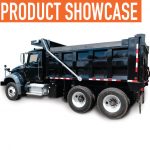Looking back on 20 years in operations and safety leadership in the trucking industry, I’ve learned many things. Our business is always changing. To be successful, companies must learn to plan for changes and evolve quickly to meet the demands of the market.
There are new ways to do things that lead to better efficiency, cost savings, and stronger employee retention through driving wellness and active caring. Frankly, it’s an area most safety execs didn’t even consider until recently, but I’d like to share how they now offer breakthrough advantages.
Innovations like Power Steering, Electronic Logs, and Crash Mitigation Systems were once viewed as unnecessary or with a mistrustful eye. As drivers try different technologies and share their experiences, the transportation landscape changes and evolves.
In my opinion, the true success of any organization can be directly measured by its ability to control loss. It’s not enough to price well, sell, and bill. One accident can wipe out all the hard work. Knowing how to identify risk, its counter measures, and defining what success in safety looks like is imperative for every fleet owner today.
THE PROVERBIAL FLAT TIRE
At the foundation of any successful company, employee safety and well-being is a core value, not a priority. Priorities in business change every day. If my main priority this morning was to drive into work, and I have a flat tire on the way in, then my priority changes to adapt to these new conditions. Now changing the tire becomes the priority. If you only look at safety as a priority, then your organization may allow safety to be compromised as that proverbial flat tire bubbles up.
The core value commitment is not just a stated purpose, but needs to be demonstrated through active caring. Caring is being concerned that someone could get hurt by unsafely operating a piece of equipment. Actively caring is walking over to the individual operating the equipment and respectfully showing the person the correct way to do it.
At its core, safety is about placing value on life and controlling/eliminating the loss of life. Getting your arms around fatigue is one key way to uphold your commitment to safety.

TIME, MONEY, AND MATLOCK
There has been a lot of increasing dialogue regarding Fatigue Management Programs (FMP), particularly since FMCSA, ATRI, and several other industry regulatory agencies (both in the US and Canada) published the framework for a program back in 2013 called NAFMP (www.nafmp.com). The implementation manual that you can download from that website is very informative and gives a great blueprint for forming your own program. Many of the ideas they give are easy to implement and free of charge.
Why should you worry about it? I can imagine that there are defense attorneys out there who will tell you that you need a Fatigue Management Program (FMP) because it would help them defend you in a fatigue-related crash. I can’t speak for the legal advice—I’ll leave that to you and Matlock (or Lionel Hutz.) What I can say, is that I believe having a robust FMP will help you and your company save time, money, and help reduce fatigue-related accidents and incidents.
You demonstrate active caring to your drivers and staff by your commitment to their rest and well-being. Simply put, having a good FMP is the right thing to do.![]()
ABOUT THE AUTHOR:
US Army veteran and senior vice president, Business Development/New Ventures at SleepSafe Drivers®, Steven Garrish, has more than 20 years of experience in logistics and transportation serving 14 years at JB Hunt Transport Company, Inc., in Human Resources Operations and Safety. Joining Walmart in 2010, Steven worked as senior director, Private Fleet Safety, leading safety efforts for Walmart’s private fleet of more than 7,500 professional truck drivers nationwide.
_______________________________________________________________________
MODERN WORKTRUCK SOLUTIONS: JANUARY 2016 ISSUE
Did you enjoy this article?
Subscribe to the FREE Digital Edition of Modern WorkTruck Solutions magazine.
![]()





